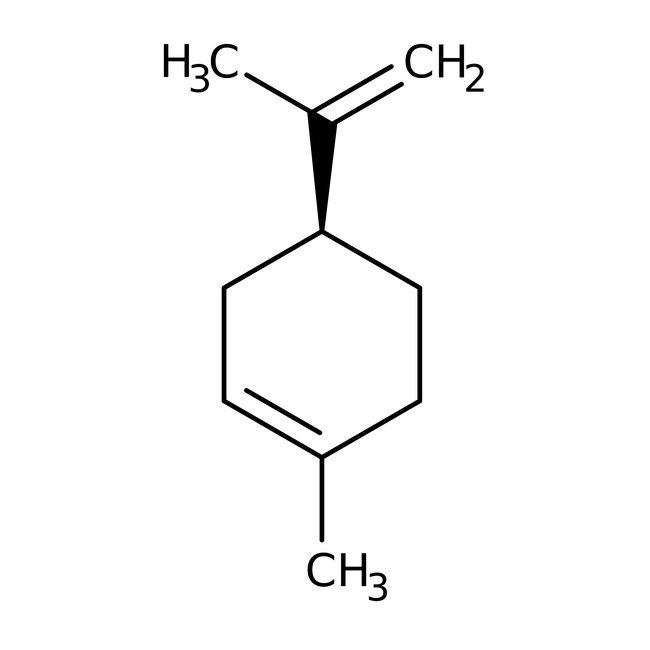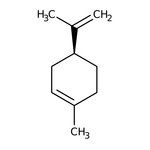Search Thermo Fisher Scientific
Thermo Scientific Chemicals
(S)-(-)-Limonene, 97%
CAS: 5989-54-8 | C10H16 | 136.238 g/mol
Catalog number ALFL13244.30
View Price:Sign InSign in to see your account pricing. Need an account? Register with us today.
Quantity:
250 g
Specifications
Chemical Name or Material(S)-(-)-Limonene
CAS5989-54-8
Health Hazard 1H226-H304-H315-H317-H319-H335
Health Hazard 2GHS H Statement
H226-H315-H317
Flammable liquid and vapor.
Causes skin irritation.
May cause an allergic skin reaction.
H226-H315-H317
Flammable liquid and vapor.
Causes skin irritation.
May cause an allergic skin reaction.
Health Hazard 3P210-P233-P240-P241-P242-P243-P261-P264b-P272-P280-P301+P310-P303+P361+P353-P305+P351+P338-P331-P333+P313-P363-P370+P378q-P501c
View more
(S)-(-)-Limonene is used to inhibit the proliferation of colon cancer cells. It is also used in artificial essential oils in order to produce (+)-carvone. It is an active component of turpentine. Further, it is used in flavorings, fragrances, and cosmetics. It finds application as a solvent and wetting agent. In addition to this it is used to produce resins.
This Thermo Scientific Chemicals brand product was originally part of the Alfa Aesar product portfolio. Some documentation and label information may refer to the legacy brand. The original Alfa Aesar product / item code or SKU reference has not changed as a part of the brand transition to Thermo Scientific Chemicals.
Applications
(S)-(-)-Limonene is used to inhibit the proliferation of colon cancer cells. It is also used in artificial essential oils in order to produce (+)-carvone. It is an active component of turpentine. Further, it is used in flavorings, fragrances, and cosmetics. It finds application as a solvent and wetting agent. In addition to this it is used to produce resins.
Solubility
Miscible with alcohol. Immiscible with water.
Notes
Incompatible strong oxidizing agents, acids, strong bases and peroxides.
(S)-(-)-Limonene is used to inhibit the proliferation of colon cancer cells. It is also used in artificial essential oils in order to produce (+)-carvone. It is an active component of turpentine. Further, it is used in flavorings, fragrances, and cosmetics. It finds application as a solvent and wetting agent. In addition to this it is used to produce resins.
Solubility
Miscible with alcohol. Immiscible with water.
Notes
Incompatible strong oxidizing agents, acids, strong bases and peroxides.
RUO – Research Use Only
General References:
- Molina, G.; Bution, M. L.; Bicas, J. L.; Dolder, M. A. H.; Pastore, G. M. Comparative study of the bioconversion process using R-(+)- and S-(-)-limonene as substrates for Fusarium oxysporum 152B. Food Chem. 2015, 174, 606-613.
- Willrodt, C.; Karande, R.; Schmid, A.; Julsing, M. K. Guiding efficient microbial synthesis of non-natural chemicals by physicochemical properties of reactants. Curr. Opin. Biotechnol. 2015, 35, 52-62.



